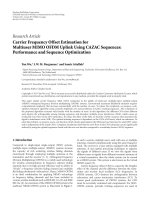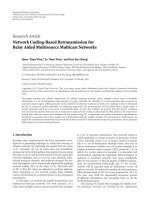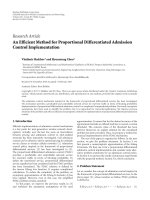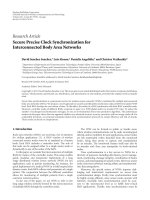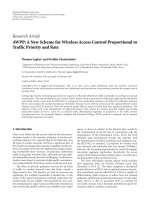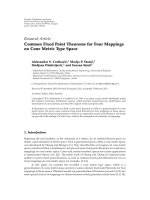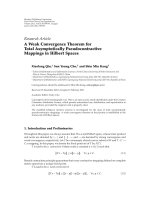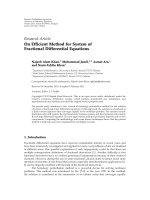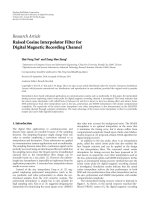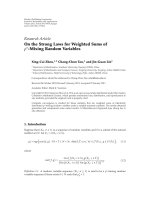Báo cáo hóa học: " Research Article Second Moment Convergence Rates for Uniform Empirical Processes" ppt
Bạn đang xem bản rút gọn của tài liệu. Xem và tải ngay bản đầy đủ của tài liệu tại đây (478.34 KB, 9 trang )
Hindawi Publishing Corporation
Journal of Inequalities and Applications
Volume 2010, Article ID 972324, 9 pages
doi:10.1155/2010/972324
Research Article
Second Moment Convergence Rates for Uniform
Empirical Processes
You-You Chen and Li-Xin Zhang
Department of Mathematics, Zhejiang University, Hangzhou 310027, China
Correspondence should be addressed to You-You Chen,
Received 21 May 2010; Revised 3 August 2010; Accepted 19 August 2010
Academic Editor: Andrei Volodin
Copyright q 2010 Y Y. Chen and L X. Zhang. This is an open access article distributed under
the Creative Commons Attribution License, which permits unrestricted use, distribution, and
reproduction in any medium, provided the original work is properly cited.
Let {U
1
,U
2
, ,U
n
} be a sequence of independent and identically distributed U0, 1-distributed
random variables. Define the uniform empirical process as α
n
tn
−1/2
n
i1
I{U
i
≤ t}−t, 0 ≤
t ≤ 1, α
n
sup
0≤t≤1
|α
n
t|. In this paper, we get the exact convergence rates of weighted infinite
series of Eα
n
2
I{α
n
≥εlog n
1/β
}.
1. Introduction and Main Results
Let {X, X
n
; n ≥ 1} be a sequence of independent and identically distributed i.i.d. random
variables with zero mean. Set S
n
n
i1
X
i
for n ≥ 1, and log x lnx ∨ e. Hsu and Robbins
1 introduced the concept of complete convergence. They showed that
∞
n1
P
{|
S
n
|
≥ εn
}
< ∞,ε>0
1.1
if EX 0andEX
2
< ∞. The converse part was proved by the study of Erd
¨
os in 2. Obviously,
the sum in 1.1 tends to infinity as ε 0. Many authors studied the exact rates in terms of ε
cf. 3–5.Chow6 studied the complete convergence of E{|S
n
|−εn
α
}
, ε>0. Recently, Liu
and Lin 7 introduced a new kind of complete moment convergence which is interesting,
and got the precise rate of it as follows.
2 Journal of Inequalities and Applications
Theorem A. Suppose that {X, X
n
; n ≥ 1} is a sequence of i.i.d. random variables, then
lim
ε0
1
−log ε
∞
n1
1
n
2
ES
2
n
I
{|
S
n
|
≥ εn
}
2σ
2
1.2
holds, if and only if EX 0, EX
2
σ
2
, and EX
2
log
|X| < ∞.
Other than partial sums, many authors investigated precise rates in some different
cases, such as U-statistics cf. 8, 9 and self-normalized sums cf. 10, 11. Zhang and
Yang 12 extended the precise asymptotic results to the uniform empirical process. We
suppose U
1
,U
2
, ···,U
n
is the sample of U0, 1 random variables and E
n
t is the empirical
distribution function of it. Denote the uniform empirical process by α
n
t
√
nE
n
t − t,
0 ≤ t ≤ 1, and the norm of a function ft on 0, 1 by f sup
0≤t≤1
|ft|.LetBt, t ∈ 0, 1
be the Brownian bridge. We present one result of Zhang and Yang 12 as follows.
Theorem B. For any δ>−1, one has
lim
ε0
ε
2δ2
∞
n1
log n
δ
n
P
α
n
≥ ε
log n
E
B
2δ2
δ 1
.
1.3
Inspired by the above conclusions, we consider second moment convergence rates for
the uniform empirical process in the law of iterated logarithm and the law of t he logarithm.
Throughout this paper, let C denote a positive constant whose values can be different from
one place to another. x will denote the largest integer ≤ x. The following two theorems are
our main results.
Theorem 1.1. For 0 <β≤ 2,δ>2/β − 1, one has
lim
ε0
ε
βδ1−2
∞
n2
log n
δ−2/β
n
E
α
n
2
I
α
n
≥ ε
log n
1/β
βE
B
βδ1
β
δ 1
− 2
.
1.4
Theorem 1.2. For 0 <β≤ 2,δ>2/β − 1, one has
lim
ε0
ε
βδ1−2
∞
n3
log log n
δ−2/β
n log n
E
α
n
2
I
α
n
≥ ε
log log n
1/β
βE
B
βδ1
β
δ 1
− 2
.
1.5
Journal of Inequalities and Applications 3
Remark 1.3. It is well known that P{B≥x} 2
∞
k1
−1
k1
e
−2k
2
x
2
, x>0 see Cs
¨
org
˝
oand
R
´
ev
´
esz 13, page 43. Therefore, by Fubini’s theorem we have
E
B
βδ1
β
δ 1
∞
0
x
βδ1−1
P
{
B
≥ x
}
dx
2β
δ 1
∞
0
x
βδ1−1
∞
k1
−1
k1
e
−2k
2
x
2
dx
β
δ 1
Γ
β
δ 1
/2
2
βδ1/2
∞
k1
−1
k1
k
−βδ1
.
1.6
Consequently, explicit results of 1.4 and 1.5 can be calculated further.
2. The Proofs
In order to prove Theorem 1.1, we present several propositions first.
Proposition 2.1. For β>0, δ>−1, one has
lim
ε0
ε
βδ1
∞
n2
log n
δ
n
P
B
≥ ε
log n
1/β
E
B
βδ1
δ 1
.
2.1
Proof. We calculate that
lim
ε0
ε
βδ1
∞
n2
log n
δ
n
P
B
≥ ε
log n
1/β
lim
ε0
ε
βδ1
∞
2
log y
δ
y
P
B
≥ ε
log y
1/β
dy
β
∞
0
t
βδ1−1
P
{
B
≥ t
}
dt
E
B
βδ1
δ 1
.
2.2
Proposition 2.2. For β>0,δ>−1, one has
lim
ε0
ε
βδ1
∞
n2
log n
δ
n
P
α
n
≥ ε
log n
1/β
− P
B
≥ ε
log n
1/β
0.
2.3
4 Journal of Inequalities and Applications
Proof. Following 4,setAεexpM/ε
β
, where M>1. Write
∞
n2
log n
δ
n
P
α
n
≥ ε
log n
1/β
− P
B
≥ ε
log n
1/β
n≤Aε
log n
δ
n
P
α
n
≥ ε
log n
1/β
− P
B
≥ ε
log n
1/β
n>Aε
log n
δ
n
P
α
n
≥ ε
log n
1/β
− P
B
≥ ε
log n
1/β
: I
1
I
2
.
2.4
It is wellknown that α
n
·
d
→ B·see Cs
¨
org
˝
oandR
´
ev
´
esz 13, page 17. By continuous
mapping theorem, we have α
n
d
→B. As a result, it follows that
Δ
n
: sup
x
|
P
{
α
n
≥ x
}
− P
{
B
≥ x
}|
−→ 0, as n −→ ∞.
2.5
Using the Toeplitz’s lemma see Stout 14, pages 120-121, we can get lim
ε0
ε
βδ1
I
1
0. For
I
2
, it is obvious that
I
2
≤
n>Aε
log n
δ
n
P
B
≥ ε
log n
1/β
n>Aε
log n
δ
n
P
α
n
≥ ε
log n
1/β
: I
3
I
4
.
2.6
Notice that Aε − 1 ≥
Aε, for a small ε. Via the similar argument in 4 we have
ε
βδ1
I
3
≤ ε
βδ1
n>Aε
log n
δ
n
P
B
≥ ε
log n
1/β
≤ C
∞
M/2
1β
y
βδ1−1
P
B
≥ y
dy −→ 0, as M −→ ∞.
2.7
From Kiefer and Wolfowitz 15, we have
P
{
α
n
≥ x
}
≤ Ce
−Cx
2
.
2.8
Journal of Inequalities and Applications 5
Therefore,
ε
βδ1
I
4
≤ Cε
βδ1
n>Aε
log n
δ
n
exp
−Cε
2
log n
2/β
≤ Cε
βδ1
∞
√
Aε
log x
δ
x
exp
−Cε
2
log x
2/β
dx
≤ C
∞
C
M/2
2/β
y
βδ1/2−1
e
−y
dy −→ 0, as M −→ ∞.
2.9
From 2.6, 2.7,and2.9, we get lim
ε0
ε
βδ1
I
2
0. Proposition 2.2 has been proved.
Proposition 2.3. For β>0,δ>2/β − 1, one has
lim
ε0
ε
βδ1−2
∞
n2
log n
δ−2/β
n
∞
ε
log n
1/β
2yP
B
≥ y
dy
2E
B
βδ1
δ 1
β
δ 1
− 2
.
2.10
Proof. The calculation here is analogous to 2.1, so it is omitted here.
Proposition 2.4. For 0 <β≤ 2,δ>2/β − 1, one has
lim
ε0
ε
βδ1−2
∞
n2
log n
δ−2/β
n
∞
εlog n
1/β
2yP
α
n
≥ y
dy −
∞
εlog n
1/β
2yP
B
≥ y
dy
0.
2.11
Proof. Like 4 and Proposition 2.2, we divide the summation into two parts,
∞
n2
log n
δ−2β
n
∞
εlog n
1/β
2yP
α
n
≥ y
dy −
∞
εlog n
1/β
2yP
B
≥ y
dy
n≤Aε
log n
δ−2β
n
∞
εlog n
1/β
2yP
α
n
≥ y
dy −
∞
εlog n
1/β
2yP
B
≥ y
dy
n>Aε
log n
δ−2/β
n
∞
εlog n
1/β
2yP
α
n
≥ y
dy −
∞
εlog n
1/β
2yP
B
≥ y
dy
: J
1
J
2
.
2.12
6 Journal of Inequalities and Applications
First, consider J
1
,
J
1
≤
n≤Aε
log n
δ−2/β
n
∞
εlog n
1/β
2y
P
α
n
≥ y
− P
B
≥ y
dy
≤
n≤A
ε
log n
δ
n
∞
0
2
x ε
P
α
n
≥
x ε
log n
1/β
− P
B
≥
x ε
log n
1/β
dx
≤
n≤A
ε
log n
δ
n
log n
−1/β
Δ
−1/4
n
0
2
x ε
P
α
n
≥
x ε
log n
1/β
−P
B
≥
x ε
log n
1/β
dx
∞
log n
−1/β
Δ
−1/4
n
2
x ε
P
B
≥
x ε
log n
1/β
dx
∞
log n
−1/β
Δ
−1/4
n
2
x ε
P
α
n
≥
x ε
log n
1/β
dx
:
n≤A
ε
log n
δ
n
J
11
J
12
J
13
.
2.13
Since n ≤ Aε means ε<M/ log n
1/β
, it follows
log n
2/β
J
11
≤
log n
2/β
log n
−1/β
Δ
−1/4
n
0
2
x ε
Δ
n
dx
≤
log n
2/β
Δ
n
log n
−1/β
Δ
−1/4
n
log n
−1/β
M
1/β
2
≤
Δ
1/4
n
M
1/β
Δ
1/2
n
2
−→ 0, as n −→ ∞.
2.14
By Lemma 2.1 in Zhang and Yang 12, we have P{B≥x}≤2e
−2x
2
. For J
12
,itiseasytoget
log n
2/β
J
12
≤
log n
2/β
∞
εlog n
1/β
Δ
−1/4
n
log n
−2/β
· 2yP
B
≥ y
dy
≤ C
∞
Δ
−1/4
n
2y exp
−2y
2
dy
≤ C exp
−2Δ
−1/2
n
−→ 0, as n −→ ∞.
2.15
Journal of Inequalities and Applications 7
In the same way, by the inequality P {α
n
≥x}≤Ce
−Cx
2
, we can get
log n
2/β
J
13
≤ C exp
−CΔ
−1/2
n
−→ 0, as n −→ ∞. 2.16
Put the three parts together, we get that log n
2/β
J
11
J
12
J
13
→ 0 uniformly in ε as
n →∞. Using Toeplitz’s lemma again, we have lim
ε0
ε
βδ1−2
J
1
0.
In the sequel, we verify lim
ε0
ε
βδ1−2
J
2
0. It is easy to see that
J
2
≤
n>Aε
log n
δ−2/β
n
∞
εlog n
1/β
2xP
{
B
≥ x
}
dx
n>Aε
log n
δ−2/β
n
∞
εlog n
1/β
2xP
{
α
n
≥ x
}
dx
: J
21
J
22
.
2.17
We estimate J
22
first, by noticing 0 <β≤ 2and2.8, it follows
J
22
≤
n>Aε
log n
δ−2/β
n
∞
n
2ε
log y
1/β
P
α
n
≥ ε
log y
1/β
ε
βy
log y
1/β−1
dy
≤ C
∞
Aε
log x
δ−2/β
x
∞
x
ε
2
log y
2/β−1
y
exp
−Cε
2
log y
2/β
dy dx
≤ C
∞
Aε
ε
2
log y
2/β−1
y
exp
−Cε
2
log y
2/β
log y
δ−2/β1
dy
≤ Cε
2
∞
Aε
log y
δ
y
exp
−Cε
2
log y
dy
≤ Cε
2
log
δ
A
ε
A
ε
Cε
2
≤ Cε
2−βδ
.
2.18
Therefore, we get lim
ε0
ε
βδ1−2
J
22
0. So far, we only need to prove lim
0
ε
βδ1−2
J
21
0.
Use the inequality P{B≥x}≤2e
−2x
2
again and follow the proof of J
22
, we can get this
result. The proof of the proposition is completed now.
Proof of Theorem 1.1. According to Fubini’s theorem, it is easy to get
EXI
{
X ≥ a
}
aP
{
X ≥ a
}
∞
a
P
{
X ≥ x
}
dx,
2.19
8 Journal of Inequalities and Applications
for a>0. Therefore, we have
E
α
n
2
I
α
n
≥ ε
log n
1/β
ε
2
log n
2/β
P
α
n
≥ ε
log n
1/β
∞
εlog n
1/β
2yP
α
n
≥ y
dy.
2.20
From Proposition 2.1– 2.4, we have
lim
ε0
ε
βδ1−2
∞
n2
log n
δ−2/β
n
E
α
n
2
I
α
n
≥ ε
log n
1/β
lim
ε0
ε
βδ1
∞
n2
log n
δ
n
P
α
n
≥ ε
log n
1/β
lim
ε0
ε
βδ1−2
∞
n2
log n
δ−2/β
n
∞
εlog n
1/β
2yP
α
n
≥ y
dy
βE
B
βδ1
β
δ 1
− 2
.
2.21
a
Proof of Theorem 1.2. From 2.19, we have
ε
βδ1−2
∞
n3
log log n
δ−2/β
n log n
E
α
n
2
I
α
n
≥ ε
log log n
1/β
ε
βδ1−2
∞
n3
log log n
δ−2/β
n log n
∞
εlog log n
1/β
2yP
α
n
≥ y
dy
ε
βδ1
∞
n3
log log n
δ
n log n
P
α
n
≥ ε
log log n
1/β
.
2.22
Via the similar argument in Proposition 2.1 and 2.2,
lim
ε0
ε
βδ1
∞
n3
log log n
δ
n log n
P
α
n
≥ ε
log log n
1/β
E
B
βδ1
δ 1
.
2.23
Also, by the analogous proof of Proposition 2.3 and 2.4,
lim
ε0
ε
βδ1−2
∞
n3
log log n
δ−2/β
n log n
∞
εlog log n
1/β
2yP
α
n
≥ y
dy
2E
B
βδ1
δ 1
β
δ 1
− 2
.
2.24
Combine 2.22, 2.23,and2.24together, we get the result of Theorem 1.2.
Journal of Inequalities and Applications 9
Acknowledgment
This work was supported by NSFC No. 10771192 and ZJNSF No. J20091364.
References
1 P. L. Hsu and H. Robbins, “Complete convergence and the law of large numbers,” Proceedings of the
National Academy of Sciences of the United States of America, vol. 33, pp. 25–31, 1947.
2 P. E rd
¨
os, “On a theorem of Hsu and Robbins,” Annals of Mathematical Statistics, vol. 20, pp. 286–291,
1949.
3 R. Chen, “A remark on the tail probability of a distribution,” Journal of Multivariate Analysis, vol. 8,
no. 2, pp. 328–333, 1978.
4 A. Gut and A. Sp
˘
ataru, “Precise asymptotics in the Baum-Katz and Davis laws of large numbers,”
Journal of Mathematical Analysis and Applications, vol. 248, no. 1, pp. 233–246, 2000.
5 C. C. Heyde, “A supplement to the strong law of large numbers,” Journal of Applied Probability, vol.
12, pp. 173–175, 1975.
6 Y. S. Chow, “On the rate of moment convergence of sample sums and extremes,” Bulletin of the Institute
of Mathematics, vol. 16, no. 3, pp. 177–201, 1988.
7 W. Liu and Z. Lin, “Precise asymptotics for a new kind of complete moment convergence,” Statistics
& Probability Letters, vol. 76, no. 16, pp. 1787–1799, 2006.
8 K A. Fu, “Asymptotics for the moment convergence of U-statistics in LIL,” Journal of Inequalities and
Applications, vol. 2010, Article ID 350517, 8 pages, 2010.
9 J. G. Yan and C. Su, “Precise asymptotics of U-statistics,” Acta Mathematica Sinica, vol. 50, no. 3, pp.
517–526, 2007 Chinese.
10 T X. Pang, L X. Zhang, and J. F. Wang, “Precise asymptotics in the self-normalized law of the iterated
logarithm,” Journal of Mathematical Analysis and Applications, vol. 340, no. 2, pp. 1249–1262, 2008.
11 Q P. Zang, “A limit theorem for the moment of self-normalized sums,” Journal of Inequalities and
Applications, vol. 2009, Article ID 957056, 10 pages, 2009.
12 Y. Zhang and X Y. Yang, “Precise asymptotics in the law of the iterated logarithm and the complete
convergence for uniform empirical process,” Statistics & Probability Letters, vol. 78, no. 9, pp. 1051–
1055, 2008.
13 M. Cs
¨
org
˝
oandP.R
´
ev
´
esz, Strong Approximations in Probability and Statistics, Probability and
Mathematical Statistics, Academic Press, New York, NY, USA, 1981.
14 W. F. Stout, Almost Sure Convergence, Academic Press, New York, NY, USA, 1974, Probability and
Mathematical Statistics, Vol. 2.
15 J. Kiefer and J. Wolfowitz, “On the deviations of the empiric distribution function of vector chance
variables,” Transactions of the American Mathematical Society, vol. 87, pp. 173–186, 1958.
